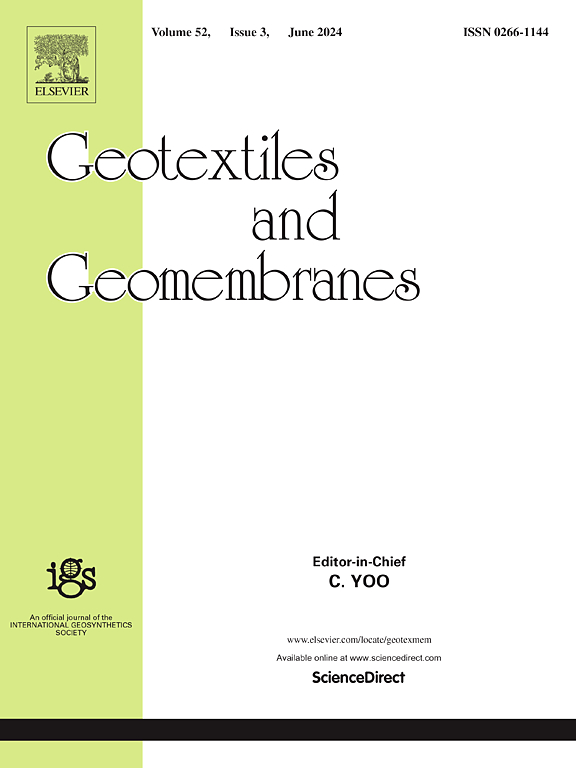复合防渗墙通过土工膜接缝缺陷渗漏
IF 6.2
1区 工程技术
Q1 ENGINEERING, GEOLOGICAL
引用次数: 0
摘要
复合土工膜-土壤-膨润土(CGSB)防渗墙是截流高侵蚀性地下水的有效屏障。土工膜(GM)接缝在安装过程中不可避免地会出现缺陷,从而产生优先流道。设计了一种测量CGSB壁面接缝缺陷流速Q的实验装置。通过实验和数值模拟研究了CGSB墙体的泄漏特性。结果表明:土-膨润土(SB)在压力下进入节理,具有类似于亲水性垫片的密封作用,有效降低了Q值,随着水头hw的增大,节理内部间隙宽度增大,导致Q值显著增大,当hw从1 m增大到2 m时,测得Q值的最大增幅超过17.6倍;与未填充SB的情况相比,填充SB的接头断裂孔径df减小了一个数量级。当df < 0.1 mm时,CGSB墙体渗漏主要受df控制;当df > 0.2 mm时,泄漏量主要受GM - SB界面透过率的影响。本文章由计算机程序翻译,如有差异,请以英文原文为准。
Leakage of composite cutoff walls through geomembrane joint defects
Composite geomembrane-soil-bentonite (CGSB) cutoff walls are effective barriers to contain highly aggressive contaminated groundwater. Defects in the geomembrane (GM) joint are inevitable during the installation, inducing preferential flow paths. An experimental device is designed to measure the flow rate through the joint defects of CGSB walls. Experiments and numerical simulations are performed to investigate the leakage characteristics of CGSB walls. The results show that soil-bentonite (SB) enters the joint under pressure and has a sealing effect similar to a hydrophilic gasket, which effectively reduces the . As the hydraulic head increases, the internal gap width of the joint increases, resulting in a significant increase in . When increases from 1 to 2 m, the maximum increase in the measured exceeds 17.6 times. The fracture pore diameter of the joint filled with SB decreases by an order of magnitude compared to the case without SB filling. When is less than 0.1 mm, the leakage of the CGSB wall is mainly controlled by ; while is greater than 0.2 mm, the leakage is mainly affected by the interface transmissivity between the GM and SB.
求助全文
通过发布文献求助,成功后即可免费获取论文全文。
去求助
来源期刊

Geotextiles and Geomembranes
地学-地球科学综合
CiteScore
9.50
自引率
21.20%
发文量
111
审稿时长
59 days
期刊介绍:
The range of products and their applications has expanded rapidly over the last decade with geotextiles and geomembranes being specified world wide. This rapid growth is paralleled by a virtual explosion of technology. Current reference books and even manufacturers' sponsored publications tend to date very quickly and the need for a vehicle to bring together and discuss the growing body of technology now available has become evident.
Geotextiles and Geomembranes fills this need and provides a forum for the dissemination of information amongst research workers, designers, users and manufacturers. By providing a growing fund of information the journal increases general awareness, prompts further research and assists in the establishment of international codes and regulations.
 求助内容:
求助内容: 应助结果提醒方式:
应助结果提醒方式:


